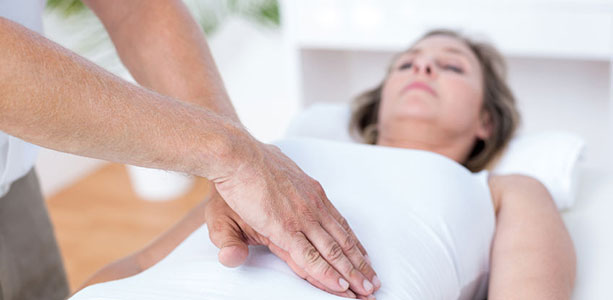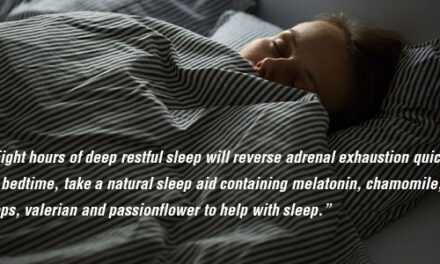I knew from the tension in Rosie’s voice that something was wrong. She phoned me in a panic after her doctor told her that her heavy menstrual bleeding was caused by uterine fibroids. She was hoping to avoid the only option offered to her by her doctor—a hysterectomy.
Fibroids were a complete mystery to Rosie, as they are to many women. I reassured her there were many ways to reduce, if not totally eliminate, fibroids. Before considering a hysterectomy, I encouraged her to incorporate a plan that included dietary and lifestyle changes as well as nutritional supplementation. She decided to give a more holistic approach a try.
Fibroids and Hormonal Imbalance
Fibroids are quite common and found in 20 – 30 percent of all women by the age of 40 and more than 40 percent of women have them by the time they reach menopause.
The most important fact about fibroids is that they are benign (non-cancerous) tumors. A fibroid is formed from excess fibrin (scar tissue), smooth muscle tissue, and generally, pockets of estrogen. They are found on and within the uterine wall or in the uterine cavity and can vary in size from being very small to weighing several pounds.
It is estimated that 75 percent of women are unaware they have fibroids since they are symptom-free. The most common symptom of fibroids is heavy menstrual bleeding, often with large clots. Regular cycles of heavy bleeding can lead to anemia. The size or position of a fibroid can exert pressure on the bladder, bowels or sensitive pelvic nerves, causing a variety of symptoms including pelvic pain, frequent urination, constipation, low back pain, and irritable bowel.
Although fibroids are the number one reason that doctors perform a hysterectomy, there are, in fact, many effective, natural treatments that can successfully resolve fibroids.
Balance Hormones, Banish Fibroids
Fibroids are hormone dependent, thriving on estrogen. The primary cause of fibroids is a hormonal imbalance caused by an excess of estrogen and a deficiency of progesterone.
This estrogen “dominance” can be fueled by many things including the use of “the Pill”, fertility drugs, or hormone replacement therapy. Other contributing factors to estrogen excess include bowel toxicity, liver congestion, inflammation, heavy metal toxicity, hypothyroidism and exposure to environmental estrogens (e.g., organochlorine pesticides, pharmacologic compounds). From my clinical practice, I have also observed that stress from unresolved emotional conflicts regarding creativity, reproduction, and relationships can often exacerbate hormonal imbalances.
Since there is a direct relationship between fibroids and estrogen excess, restoring balance by increasing progesterone levels is necessary. Trans-dermal natural progesterone cream, a bio-identical source of progesterone, helps to restore this crucial balance. The recommended dose is 1/8 to 1/2 teaspoon rubbed twice daily (AM and PM) on soft tissue such as the abdomen, inner arms, or inner thighs usually from day 13 – 26 of the menstrual cycle.
A standardized extract of the herb chaste tree berry (140 to 275 milligrams daily) has been shown to also increase progesterone levels. However, it may take three or four months before its full benefit is experienced.
In general, all foods that promote estrogen excess must be reduced or avoided: all non-organic, processed foods, dairy products, sugar, refined carbohydrates, unfermented soy products, alcohol, and coffee. Environmental estrogens are also found in personal care products, cosmetics, household cleaning products, plastics, and all forms of pesticides. Whenever possible, use only organic chemical-free products.
Fibroids and Your Liver
The liver plays an important role in hormonal balance. Estrogen is deactivated by the liver before being eliminated from the body. Liver problems and liver congestion will raise levels of circulating estrogen and thus aggravate fibroid growth. A vitamin B-complex (100 mg) helps support the liver by enabling it to break down estrogens while vitamin E (600 IU) will regulate bleeding and normalize estrogen levels.
Indole-3-carbinole (150 to 300 mg daily), an active ingredient of cruciferous vegetables such as broccoli, Brussels sprouts, cabbage and cauliflower, has a powerful effect on the liver’s ability to properly metabolize estrogens. The supplement Calcium D-glucarate (150 to 300 mg daily), a natural substance found in many fruits and vegetables clears estrogens and xeno-estrogens out of the body. Liver support herbs such as milk thistle, dandelion, goldenseal, barberry, and artichoke detoxify a wide range of hormones, drugs, and toxins. The B-compound vitamins, choline, inositol, and methionine, are excellent for liver cleansing.
Regular exercise is essential to help reduce the growth of fibroids.
Once released from the liver into the small and large intestines, estrogen may be reabsorbed back into the body if the intestines are sluggish. Since slow transit time and constipation increases estrogen levels—increasing water consumption, fiber intake, and taking bowel-cleansing herbs will aid proper elimination.
The Benefits of Castor Oil Packs and Coffee Enemas
Two other effective strategies for eliminating fibroids includes the use of castor oil packs to increase healthy circulation of the pelvic cavity and weekly use of coffee enemas for liver detoxification.
Castor oil has a long history of traditional medical use dating back to ancient Egypt. Castor oil is derived from the castor bean (Ricinus communis).
Castor oil appears to have a unique ability to sink transdermally (through the skin) to relax smooth muscle. This simple mechanical action has a beneficial influence on all hollow organs, specifically the blood and lymph vessels, the uterus, fallopian tubes, bowels, gall bladder, and even the liver (which is not hollow but is filled with venous lakes).
A castor oil pack is placed on the skin to increase circulation and to promote elimination and healing of the tissues and organs underneath the skin. It is often used to stimulate the liver, relieve pain, increase lymphatic circulation, reduce inflammation and improve digestion.
Castor oil packs have many applications, and are specific in cases of uterine fibroids and ovarian cysts that are not cancerous. Packs also relieve ovarian pain or help with healing after a ruptured ovarian cyst. Other conditions that respond to castor oil packs include headaches, liver disorders, constipation, intestinal disorders, gallbladder inflammation or stones, and conditions with poor elimination.
Castor oil packs are made by soaking a piece of flannel in castor oil and placing it on the abdomen. The flannel is covered with a sheet of plastic, and then a hot water bottle or heating pad is placed over the plastic to heat the pack. Castor oil application increases the efficiency of circulation through your pelvis in general. Good circulation is required for supportive nutrients to be delivered to the cells, and for waste products and inflammatory factors to be removed. If a castor oil pack is placed over your liver area, it will help your liver to do its work more efficiently, including the metabolism of your hormones.
To be effective, a castor oil pack must be used at least three times a week for at least 30 – 60 minutes, although five times a week is better. In cases of long-term chronic pain, it works best to commit to a six-week treatment period using a castor oil pack five times per week, then as needed for episodes of pain.
Always choose a high quality castor oil and use cotton or wool flannel cloths if possible.
The purpose of a coffee enema is to help detoxify the liver. Enemas and colonics have been used for hundreds of years. Coffee enemas have a chemical makeup that is stimulative. The enzymes in coffee, known as palmitates, help the liver carry away the toxins in bile acid. The coffee is absorbed into the hemorrhoidal vein, then taken up to the liver by the portal vein. With the bile ducts dilated, bile carries toxins away to the gastrointestinal tract. Simultaneously, peristaltic activity is encouraged because of the flooding of the lower colon. Thus, when the colon is evacuated, the toxins and bile are carried out of the body.
The coffee enema is safe even for people who are sensitive to caffeine because the coffee remains in the sigmoid colon, where it will not be absorbed, provided the proper amount is used and the enema bag is not placed too high.
Using a coffee enema twice a week to help reduce the size of a fibroid is recommended. However it can be used more frequently. After the fibroid has shrunk, a coffee enema is a great liver detox to do once or twice a month.
Coffee Enema Recipe
- Bring 8 cups of water to a boil.
- Grind eight heaping spoonfuls of organic coffee. Put it in a french press pot. You can use a drip coffee maker, but be sure to use organic, non-bleached coffee filters.
- Pour the water over the coffee grounds and let it steep then cool for one hour or more.
- After this amount of time, the liquid should be about body temperature. If you stick your finger in the water it should be lukewarm or cool, but not hot.
- Press the coffee grounds to the bottom, then pour the coffee liquid into the enema bag.
- Never utilize flavored coffee, sweetened coffee, or coffee with milk (café au lait) for this purpose.
The Thyroid—Fibroid Connection
There is also a relationship between a sluggish thyroid and fibroids. So, it is important to assess thyroid function. A blood test is usually recommended. In addition, I suggest taking your first morning temperature, before getting out of bed. A consistent reading of 97.6 F or below indicates a low functioning thyroid.
In hypothyroidism, there is increased activity of the pituitary gland aimed at trying to stimulate the thyroid to produce more hormone secretions, and the increased pituitary activity may spill over to affect the ovaries and increase their estrogen output. Unless the health of the thyroid is considered in assessing any “female” complaint, a major contributing factor may be overlooked.
Other Useful Strategies
Since fibroids are composed of fibrin, or scar tissues, the protein-dissolving action of a systemic oral enzyme such a Serrapeptase (five tablets 3× daily an hour before or two hours after meals) has the ability to actually dissolve the hard, fibrous material of a fibroid. Serrapeptase also exerts extremely high anti-inflammatory properties, a condition associated with fibroids.
The herb, shepherd’s purse, is used to stop heavy bleeding and hemorrhaging, particularly from the uterus and is considered most effective for treating chronic uterine bleeding disorders from fibroids.
Successfully healing any health problem often requires the assistance of qualified holistic heath practitioners trained at finding the root causes of fibroids. The following modalities are effective in treating fibroids: acupuncture and Chinese herbs, naturopathy, homeopathy, Western herbal medicine, and chiropractic.
If at all possible, it is important to resolve fibroids when they’re small. Larger fibroids are more difficult to successfully treat.
Determined to avoid a hysterectomy, Rosie committed herself wholeheartedly, to a healing program. By improving her diet, using nutritional support, detoxifying her body and reducing stress, she successfully stopped the heavy bleeding, shrank her fibroids and kept her uterus.











